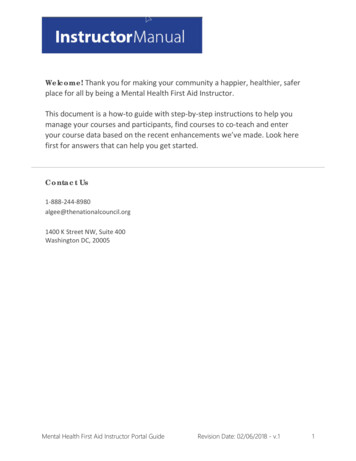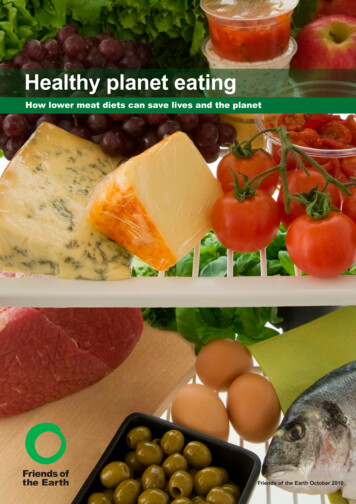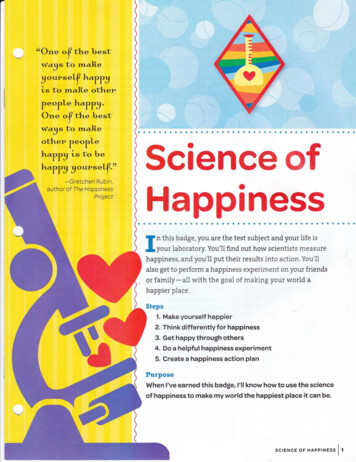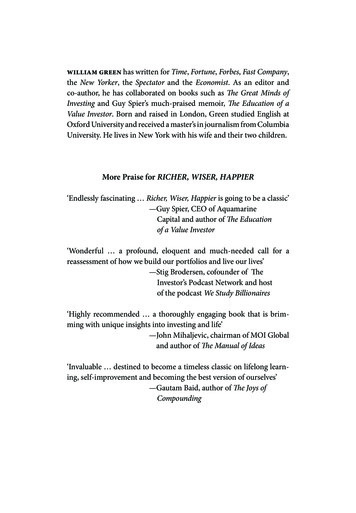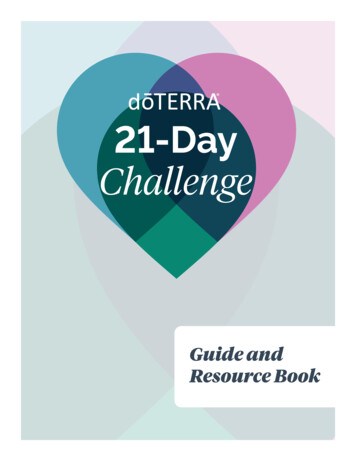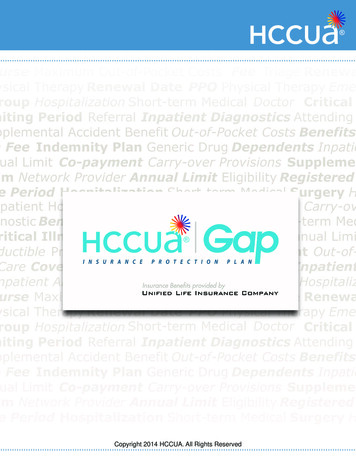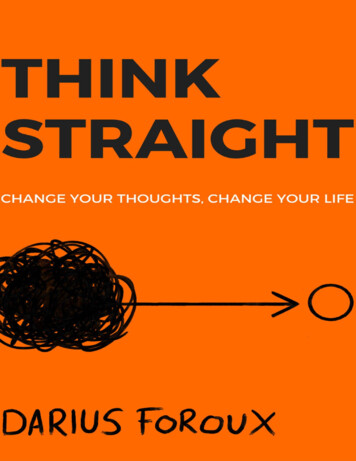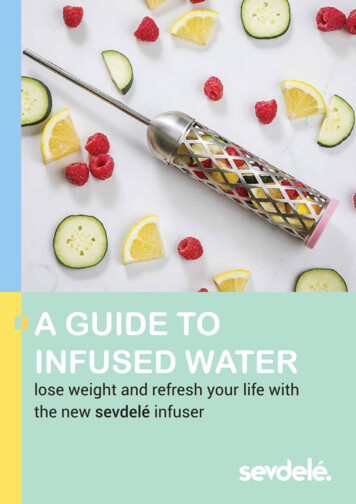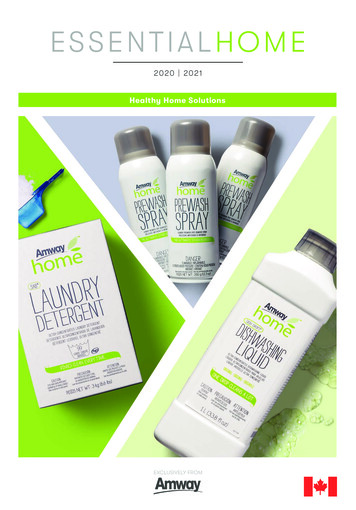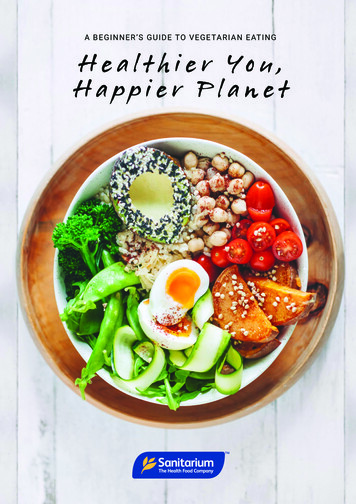
Transcription
A BEGI NNER’ S GU I DE TO V E G E TA R I A N E ATI N GHealthier You,Happier Planet
Welcome If you’re reading this, you’ve already taken your first big step towardschanging your life and the world for the better. Congrats!Studies show that choosing to eat more plant foods (vegetables, fruits,wholegrains, legumes, nuts and seeds) is a recipe to a longer, happier andhealthier life. Plus, it's the best way to reduce your impact on the environment!Changing to a mostly plant-powered diet is now easier than ever. With thisguide at your fingertips, you’ll understand the best food sources of certainnutrients and will have delicious recipe inspiration on hand to help ensureneither your body, nor your tastebuds, are ever left wanting more!Embrace the journey and have fun with it! Try different thingsand see what you like. For anything else, including additional recipes,helpful tips, and meal planning ideas, ingAll the be st,the Sanitarium team2
Contents PAGE 4Eating more plantsPAGE 5Tips for going greenPAGE 6Fruits & vegetablesPAGE 8 Common myths & misunderstandingsPAGE 11Dairy free milksPAGE 12Plant powered proteinRECIPESPAGE 16Kumara& pearl barley risotto PAGE 18Minestrone soupPAGE 20Creamy pumpkin fettucinePAGE 22Cauliflower & edamame dhalPAGE 24Spinach & tofu filled shellsPAGE 26Hokkien noodles stirfryPAGE 28Spring vegetable piePAGE 30Butter beans with rocketPAGE 32Rainbow veggie slicePAGE 34Nourish bowlPAGE 35Build a balanced vegetarian mealPAGE 36Online resources3
Eating more plantsEating more plant-based foods is a dietary trendthat’s sweeping the globe - and New Zealandersare embracing it!your energy levels, boosting your mood and evenimproving your complexion!If weight loss is one of your goals, eating moreplant foods can help. As well as being big onnutrients, plant-based foods provide plenty ofdietary fibre. This will keep you feeling full forlonger and help fend off cravings for less healthysnacks. Fibre is also vital for our hungry gutmicrobes that rely on fibre as food.In fact, 34% of us say we are now eating lessmeat – or none at all. This represents overone million people who are either flexitarians(meaning they’re actively reducing their meatconsumption), vegetarians or vegans (eating noanimal-derived foods at all). These figures alignwith findings from a recent report, which detailedthe rise of the flexitarian lifestyle and identifiedhealth as the number one reason Kiwis aremaking the plant-based switch.1Healthy worldDid you know animal foods are the planet’sleading source of greenhouse gas emissions,more than all transports combined? ForNew Zealand, about half comes from animalagriculture. Switching to a healthier diet andsimply eating in line with our Eating and ActivityGuidelines, by minimising consumption ofnutrient-poor discretionary foods, cutting backon meat (particularly those high in saturated fat)So, whether you're ready to commit to Meat-freeMondays, becoming a ‘Weekday Vegetarian' orgoing 100% plant-based, it's never been easier or tastier - to get more plants on your plate. Plusit’s a decision that can be a healthy win-win foryou and the planet.Healthy youand eating more whole plant foods; includingwholegrains and other sources of complexcarbohydrates could make a huge difference.There are many longer-term benefits of eatingmainly plant foods with research showing itcan help you live longer and reduce your risk ofchronic disease including heart disease, type 2diabetes, obesity and some cancers.From here, each move towards eating moreplants has an even better impact on theenvironment. Research that compares theenvironmental impacts of different diets showthe less animal products eaten, the lower thecarbon footprint – with the planet saying a bigthank you to vegan diets.2But what about here and now?Eating more plant foods like nutrient-rich fruits,veggies, wholegrains, legumes, nuts and seedshas a wide range of immediate health benefitsfrom supporting your immunity to increasingThe important message is that every bit helps!4
Tipsforgoinggreen PREP YOUR PLANTSEAT VEGGIESAT EVERY MEALNew Zealanders have a long way to goto meet the recommended 3 or moreserves of veggies a day, with just 62%of us managing to meet this target.To make it achievable, we really needto be striving to add veggies to everymeal. Breakfast is often the biggesthurdle but this can be as simple asadding some greens to a smoothie orspreading your toast with avo.Try prepping your veggies for the dayor the week in advance. Keep choppedup veggie sticks and fruits in thefridge for a ready-to-go snack. Premake versatile dips and spreads likehummus that can be frozen in ice cubecontainers for a single serve. Havecanned legumes in the pantry so theyare ready for the week ahead or roastup a tray of veggies to add to meals.REWORK THE RATIOSGO LOCALAND SEASONALLocal produce that’s in season isfresh, delicious and generally cheaper,so make the most of it. Stockingthe fridge with seasonal fruits andvegetables will not only inspire you toeat more plant foods, it will also helpto support local growers and is a moresustainable choice, reducing the needfor storage and transport.5If you’re not cutting out meat all together,try to stick to the dietary guidelines. It’sall too common to see oversized steaksor schnitzels falling off our plates. Therecommended size for a serve of red meatis actually about the size of a pack of playingcards. By cutting back on meat, you’llnaturally tend to load up on more veggiesachieving a healthier balance for you andthe environment.
Fruits & vegetablesSo, which fruits and vegetables should I eat?We all know that fruits and vegetables are animportant part of a healthy diet, but where doesthe advice to eat two serves of fruit and fiveserves of veg each day come from and do wereally need to eat so many?The simple answer to this is to eat the ones youlike so you can reach the goal of 2-5 a day.One of the most important benefits of fruitsand vegetables are the amount of beneficialantioxidants and phytochemicals they contain.How much fruit and vegetablesshould I eat?Antioxidants give fruits and vegetables theirdifferent colours so a handy way to make sureyou're getting a good range of antioxidants anddifferent health benefits is to choose those youlike from each of the five different colour groups.Health guidelines around the world arepretty consistent when it comes to fruits andvegetables. In New Zealand our most recentguidelines show that eating five serves ofvegetables and two serves of fruit each day isthe best approach for good health.3 Red fruits and vegetables such as tomatoes,strawberries and red capsicum. Purple and blue foods such as beetroot,blueberries and eggplant.Why should I eat fruits and vegetables?This is because fruits and vegetables are packedfull of the things our body needs, like vitamins,minerals and fibre, as well as important Yellow and orange foods such as carrots,pumpkin, corn and lemons. Green foods including the Brassica group(broccoli, cabbage, and brussels sprouts), leafygreens such as Asian greens, spinach andlettuce.antioxidants and phytochemicals. They can helpprotect against chronic diseases like type 2diabetes, heart disease and some cancers.Another big benefit of eating enough fruits andvegetables each day is that they help to replacefoods that you might want to eat less of – forexample foods high in saturated fats, addedsugar and salt. The fibre in fruits and vegetableshelps to fill you up, making them great formanaging your weight. White and brown foods such as cauliflower,mushrooms, onions, brown pears andpotatoes.Herbs and spices are a great way of toppingup the antioxidant content of your meals andhelp reduce the need for adding salt to flavourrecipes. Great herbs and spices include parsley,garlic, cinnamon, basil, cumin and ginger.6
Common myths & misunderstandingsMYTH 1My protein needs can’t be meton a plant-based dietMYTH 2Despite popular thought, plant-based dietsincluding vegetarian and vegan diets can easilymeet the recommended dietary intakes forprotein. Plant and animal proteins are made upof 20 different amino acids (the building blocksof proteins), and your body can only make 11 ofthese. The remaining 9 amino acids need to comefrom your food.It was once believed that you needed to combinecertain wholegrains and plant proteins such aslegumes or nuts with each meal to make sure youhad the best amino acid mix, however, this is nolonger the case. Your amino acid requirementscan be easily met if you eat a variety ofwholegrains, legumes, nuts, seeds, soy productsand vegetables each day and enough calories/kilojoules to maintain body weight.DID YOU KNOW?Legumes like chickpeas,kidney beans and soybeans(as well as their productslike tofu, soy milk and tempeh)are great sources of proteinand are easy to addto meals.Plant-based eaters are morelikely to be iron deficientNot true! There are two sources of iron found infood: haem iron and non-haem iron. Haem ironis only found in animal based foods and is morereadily absorbed from food than non-haem ironfrom plant foods, mostly due to phytate (a plantseed compound that binds nutrients togetherand makes it difficult for the body to absorbminerals such as iron, calcium and zinc). For thisreason, it was commonly thought that plant basedeaters and vegetarians had a higher risk of irondeficiency.But plant-based eaters are not at higher risk ofdeveloping iron deficiency if they have a diet richin wholegrains, iron-fortified cereals, legumes,nuts, seeds, dried fruits, and green leafy veggies.Eating vitamin C rich fruits and veggies with yourmeals will also help to boost the non-haem ironabsorption from plant foods, overcoming thephytate.Non haem iron from plant foods is more readilyabsorbed when our body has need for more iron,whereas haem iron is absorbed whether we needit or not. Too much haem iron is a concern as it'slinked to risk of some chronic diseases, such asdiabetes.8
DID YOU KNOW?If you’re over the age of 50, itmay be beneficial to supplementyour diet with B12. Why? Becauseyour body’s ability to absorb B12decreases as you age. VitaminB12 has also been identified asan important nutrient forpreventing Alzheimer’s.MYTH 3Plant-based eaters are morelikely to be zinc deficientSimilar to iron, phytates in wholegrains,wheat bran and legumes can reducethe amount of zinc your body absorbs.However, with normal cooking, heatingand processing such as leavening (yeast inbreads), soaking, sprouting, or fermentingthese foods you reduce the phytate leveland increase your zinc absorption.Many studies show that vegetarians do nothave a higher risk of zinc deficiency thannon-vegetarians, especially when a plantbased diet containing a variety of cookedor sprouted legumes, tofu, tempeh,wholegrain breads and cereals, nuts andseeds, is consumed.MYTH 4Fish is the only source of omega-3Omega-3 fats are typically found in oily fishand may reduce your risk of heart disease.Is there a way to get omega-3 withouteating fish?There are some valuable plant sourcesof omega-3 available, including freshlyground flaxseeds, whole chia and hempseeds, and walnuts. These omega-3sconvert to EPA (Eicosapentaenoic Acid) andDHA (Docosahexaenoic Acid) in your body.This works best when you use olive andcanola oils/margarines, instead of omega-6oils such as sunflower and safflower oils/margarines.To help boost your intake, add 1-2tablespoons of ground flaxseeds or chiaseeds to your cereal every morning.9MYTH 5Plant foods can provideyour body with enough B12The active form of B12 is naturally foundonly in animal based products includingmeat, chicken, fish, dairy and eggs.Mushrooms contain only trace amountswhich are not enough to meet your needs,and some plant foods such as tempeh,miso, spirulina, chlorella and unfortifiednutritional yeast contain only the inactiveform, making them an unreliable source.If you are vegan it is especially importantto eat foods fortified with B12 and/or takea daily B12 supplement.
Dairy free milksThere are several health benefits associated with eating a predominately plant-based diet, anddairy free milks are one way to get more plant-based foods into your diet. Dairy free milks arenaturally low in saturated fat and contain no cholesterol or lactose.We’ve got the lowdown on the most common types. Remember, try and pick a product that isfortified with calcium and vitamin B12, plus a source of protein where possible.SOY MILKALMOND MILKCOCONUT MILKRICE MILKOAT MILKSoy milk is the nutritionalking of the alternativedairy aisle, accordingto a study by Canada’sMcGill University.Researchers identifiedsoy milk as the closestto cow’s milk in terms ofoverall nutrient balanceand it also containedthe most protein of allthe milk alternatives.Researchers also notedthat soy milk containsphytonutrients, knownas isoflavones, thathave been shown tohave cancer-fightingproperties. Isoflavonesare highly protectiveagainst hormonedependent cancerssuch as breast andprostate cancers.4Amongst consumers,almond milk is oftenone of the preferredalternatives to cow’smilk due to its pleasantnutty taste, althoughit is unsuitable forthose suffering witha tree nut allergy.Almond milk tends tobe lower in kilojoulesand protein than soyand dairy milk and islower in saturated fat.Coconut milk has higheramounts of saturatedfat compared to manyother dairy free milksand is lower in calciumand protein, so usesparingly. Due to itstropical coconut flavour,it’s a nice option forsavoury dishes. Keepan eye on varietieswith no added sugar.Rice milk can be a greatalternative for thosewith dairy, soy or nutallergies. It is low insaturated fat and oftenfortified with calcium,but it is generally lowerin protein comparedto soy milk. Rice milksalso tend to have higherlevels of natural sugars,in some cases doublethe amount in soy milk.Oat milk is a deliciousmilk alternative forpeople with intolerancesand dietary restrictions,especially nut, soy ordairy allergies. Oat milkhas been touted as oneof the more sustainableplant-based milks. Ifyou’re buying oat milklook out for those thatare low in sugar andfortified with calciumand B vitamins.11
Plant powered proteinGoing vegetarian or simply cutting back on meat doesn’tmean your diet will be lower in protein. Almost all plant foodscontain this important nutrient.chickpeas has 12g of protein, and the star of plant proteins,soybeans, have a whopping 20g.Nuts are often thought of as a great source of healthy fats,but it turns out they are a major source of plant proteintoo. Just a handful of nuts (a 30g serve) can provide up to 6grams of protein.As well as helping build muscle, protein is important forbone health, recovery from injury or surgery, keeping yourappetite in check and healthy growth (especially for kids andteens). Plant protein also boasts big credentials particularlyfor heart health, cholesterol, and legumes in particular helpyou live longer. They are high in fibre, low in saturated fat andsodium, and cholesterol free. All are important credentialsCan I get all the protein I need from plants?Contrary to popular myths, vegetarians typically eat enoughor more protein than they need, as requirements aresurprisingly small. Just 46g per day for an average woman,and 64g per day for an average man. That’s 0.8g of proteinper kilogram of body weight.for heart health, but there’s more benefits as well. NutritionResearch Australia has recently summarised the past 20years of research on plant protein and health and examinedsome of the most common questions about plant protein.There are nine ‘essential’ amino acids that we need to getfrom protein foods as our body can’t make them. It’s oftenargued animal proteins are better because they contain allnine essential amino acids. But plant protein such as soy,quinoa and amaranth also contain all these essential aminoacids. If a food contains all nine of the ‘essential’ aminoacids, it is a complete protein.Why is plant protein good for you?Plant proteins are also a great source of protectivephytochemicals and plant sterols. They are an importantsource of iron and zinc, fibre and nutrients such as calcium,potassium, magnesium and folate. As we mentioned, theyare low in fat, particularly saturated fat and are cholesterolfree.Some believe for this reason that protein from plants isinferior and that it is necessary to combine various plantproteins to make them “complete”. Fortunately, when we eata variety of plant foods and enough calories to maintain ourweight, we easily get the mix of amino acids we need.Research tells us that eating plant proteins rather thananimal protein lowers our risk of various chronic diseaseslike heart disease, diabetes and hypertension. So, there arelots of reasons to substitute plant protein for animal protein.The best sources of plant protein include legumes(beans, soybeans, lentils, chickpeas), soy foods (soy milk,soy sausages/burgers, tofu, tempeh), nuts and seeds.Wholegrains such as quinoa, amaranth and wheat are alsogood sources of protein.Which plant foods are higher in protein?Legumes like chickpeas, kidney beans and soybeans (as wellas their products like tofu, soy milk and tempeh) are greatsources of protein and are easy to add to meals. A cup of12
Why are legumes healthy?Legumes have a unique nutritional profileand they're: powered by protein, with one cup (150g) ofcooked legumes or 170g of tofu (made fromsoy beans) providing a serve of protein, andmake for a super cost-effective way to eatprotein if you’re on a budget. p acked with nutrients including B vitamins,iron, zinc, calcium and magnesium. great for blood sugar control and weightloss as they have low GI (glycaemic index). f ull on for fibre which will help to fill you up,lower cholesterol, ease constipation andkeep your gut healthy. packed with phytochemicals,which have important healthprotective benefits. gluten free which makes thema fantastic option for people withcoeliac disease or gluten sensitivity.
Recipes These delicious plant based recipesare dietitian approved, nutritiousand fuss-free to make.
Kumara& pearl barley risotto SERVESPREPTIME41030INGREDIENTSINSTRUCTIONS2 tsp oil with oil and place1. Toss cubed kumaraon a baking tray. Bake in a hot oven,200 C, for 20 minutes or until golden. 2 cups kumara,cubed1 tbsp oil, extra Heat extra oil in a cast iron pot andsauté leek and thyme until leek is2.tender.1 leek, slicedFew sprigs thyme, removedfrom stem Add stock and bring mixture to the boil.3.1 litre reduced saltvegetable stock4.2 cups pearl barley, rinsed1 cup reduced salt vegetablestock, extra Stir through pearl barley and bringmixture back to the boil, then reduceheat and simmer with lid on for 20minutes, stirring occasionally. Remove lid and add extra hot stock andsimmer for remaining 10 minutes with5.lid off.¼ cup parmesan, finelygrated When pearl barley is cooked, fold through roasted kumara,parmesan6.and baby spinach leaves. Sprinkle withpepitas.2 cups baby spinach leaves1 tbsp pepita seedsNutrition Information (per serve): Energy (2118kJ, 506 calories), Protein (14.7g), Fat (13.8g), Saturated Fat (0.6g), Carbohydrate (72.7g), Sugars (6.9g),Fibre (15.5g), Sodium (947mg), Potasssium (728mg), Calcium (151mg), Iron (4.0mg).16
DID YOU KNOW?Legumes also have someunique qualities that makethem great for sustainableagriculture. They releasefewer greenhouse gases thanother crops and they helpisolate carbonin the soil.
M i n e s t ro n e s o u p SERVESPREPTIME41530INGREDIENTSINSTRUCTIONS1 tbsp oil1. Heat the oil in a large saucepanand sauté onion until soft. Add theremaining ingredients, except butterbeans.1 medium onion, finely sliced1 green capsicum, chopped140g carton tomato paste,no added salt2. Bringto the boil, then reduce heat andsimmer for 15 minutes, or until thepasta is cooked.3. Add butter beans and heat through.1 tsp Italian herbs4 cups water10g vegetable stock cube,crumbled or 2 tsp stockpowder½ cup small pasta shells440g frozen mixed vegetables310g can butter beans,drainedNutrition Information (per serve): Energy (921kJ, 220 calories), Protein (10g), Fat (6.0g), Saturated Fat (0.4g), Carbohydrate (27g), Sugars (12g),Fibre (9.8g), Sodium (306mg), Potasssium (960mg), Calcium (71mg), Iron (2.3mg).18
Creamy pumpkin fettucine SERVESPREPTIME42540INSTRUCTIONSINGREDIENTS800g pumpkin, peeled andde-seeded1.Preheat oven to 210ºC fan bake and line a largeoven tray with baking paper.2.Dice pumpkin into 1-2cm cubes and arrange onprepared tray. Add garlic cloves in the middle ofthe tray. Drizzle with oil and season with salt andpepper. Bake for 25-30 minutes, until brownedaround the edges.2 large cloves garlic, unpeeled1 tbsp olive oil3.1 1/2 cups So Good OatNo Added Sugar4 tbsp nutritional yeast2 tsp vegetable stock powder1 1/2 tsp dried sage4.Add approximately two thirds of the cooked pumpkinto the food processor or blender. Squeeze garlic outof the skin and add to processor or blender with theoat milk, nutritional yeast, stock powder, sage andpaprika. Blend until smooth and creamy.5.Bring a large saucepan of water to the boil and cookfettuccine for 10 minutes, stirring occasionally, untilal dente.6.While fettuccine cooks, transfer sauce to thefrying pan used to cook the breadcrumbs. Heat onmedium, stirring frequently, until sauce is hot andhas thickened a little. Season to taste with salt andpepper.7.Reserve 1/2 cup of the pasta cooking water, thendrain fettuccine and toss through the saucetogether with the remaining cooked pumpkin andsome of the pasta water.8.Divide between warmed serving bowls and top withbasil and breadcrumbs. Serve immediately.1/2 tsp ground paprika250g dried fettuccine2 handfuls fresh basil, roughlychoppedCRUNCHY BREADCRUMB TOPPING3 pieces bread (approximately100g)2 cloves garlic, peeledMeanwhile, make the breadcrumb topping. Usea food processor or blender to turn bread intobreadcrumbs. Crush garlic. Heat oil in a large fryingpan on medium high. Add breadcrumbs, garlic anda little salt. Cook, stirring occasionally, until goldenbrown and crisp (about 5 minutes). Transfer to aplate.2 tbsp olive oilNutrition Information (per serve): Energy (1940kJ, 463 calories), Protein (7.0g), Fat (16g), Saturated Fat (3.0g), Carbohydrate (69g), Sugars (7.0g),Fibre (4.6g), Sodium (262mg), Potasssium (382mg), Calcium (174mg), Iron (1.9mg).20
Cauliflower & edamame dhal SERVESPREPTIME61020INGREDIENTSINSTRUCTIONS1 tbsp oil1. Heat oil in a saucepan and sauté onionand garlic until onion is soft.1 medium onion, chopped2. Stir through curry paste and cook for 1minute.2 cloves garlic, crushed2 tbsp madras curry paste3. Add tomato paste, lentils, carrot,cauliflower and stock.2 tbsp no added salt tomatopaste4. Bring mixture to boil then reduce heatand simmer for 15-20 minutes or untillentils are soft.1 ½ cup dried red lentils,rinsed and drained2 carrots, chopped5. Add edamame and heat for 2 minutesor until cooked.750g cauliflower, cut intosmall florets6. Can be served with cooked brown riceor naan bread.1 litre reduced saltvegetable stock1 ½ cups frozen edamame(soybeans)Nutrition Information (per serve): Energy (1271kJ, 303 calories), Protein (18.5g), Fat (5.6g), Saturated Fat (0.6g), Carbohydrate (37.5g), Sugars (1.0g),Fibre (12.3g), Sodium (698mg), Potasssium (1120mg), Calcium (76mg), Iron (4.7mg).22
DID YOU KNOW?Studies have linked eating soyfoods, like tofu, soy milk and miso, withincreased protection from breast cancer.Eating more soy foods has also beenshown to help with lowering bloodpressure, cholesterol levels, andrisk of heart disease.
Spinach & tofu filled shells SERVESPREPTIME42030INGREDIENTSINSTRUCTIONS12 jumbo pasta shells1. Bring water to boil in a large pot andadd pasta shells. Cook until al dente,drain and cool in cold water.1 tbsp oil1 small brown onion, diced2. Heat oil in frypan add onion, garlic andshallots and sauté until soft.2 garlic cloves, minced2 shallots, finely sliced3.1/4 tsp ground nutmeg1/2 tsp salt Add nutmeg, salt and spinach. Sautéuntil spinach is wilted. Remove fromheat.4. In food processor, process tofu untilsmooth.300g baby spinach leaves5. Combine spinach mixture, tofu andnutritional yeast. Stir until wellcombined.300g silken tofu, drained2 tbsp nutritional yeast6. Pour enough passata into the base of apie dish to cover the bottom.700g bottle passata sauce1/4 cup pine nuts7 Spoon filling into pasta shells and placeshells into dish.8. Pour remaining sauce over shells.Sprinkle with pine nuts.9. Bake in a moderate oven, 180 C, for 30minutes. Serve with a green salad.Nutrition Information (per serve): Energy (2085kJ, 498 calories), Protein (20.7g), Fat (19g), Saturated Fat (2.0g), Carbohydrate (55g), Sugars (13g),Fibre (13.7g), Sodium (341mg), Potasssium (1487mg), Calcium (128mg), Iron (6.7mg).24
Hokkien noodles stirfry SERVESPREPTIME41015INSTRUCTIONSINGREDIENTS1. Cook Vegie Delights Savoury VegieMince as per cooking instructions onpack and set aside.1 packet Vegie Delights Savoury Mince1 tbsp vegetable oil2. Heat a large wok on medium to highheat, add coconut oil, garlic and gingerand cook for 3 minutes.4 cloves garlic, peeled andfinely chopped1 tsp ginger, grated3. Add coriander stalks, maple or rawsugar and stock and melt the sugarin, then add carrots, choy sum,mushrooms, shiitake mushrooms andcourgettes and cook, tossing frequentlyfor 5-6 minutes.1 1/2 tbsp maple syrup or rawsugar1/2 cup (125ml) vegetable stock4 carrots, sliced into sticks1 bunch choy sum or asian greens300g mushrooms, finely sliced4. Add Hokkien noodles, soy sauce andchilli flakes if desired and cook afurther 3-4 minutes.150g shiitake mushrooms, finelysliced2 courgettes, sliced into sticks5. Add Vegie Delights Savoury VegieMince to mixture and divide between 4bowls, top with coriander leaves, Asianshallots and serve.500g Hokkien noodles2 tbsp soy sauce or tamariChilli flakes to taste1/2 bunch coriander, leaves picked,stalks finely chopped2 Asian shallotsNutrition Information (per serve): Energy (1679 kJ, 400 calories), Protein (25g), Fat (7.0g), Saturated Fat (5.0g), Carbohydrate (56g), Sugars (16g),Fibre (17g), Sodium (860mg), Potasssium (1200mg), Calcium (114mg), Iron (8.4mg).26
Spring vegetable pie SERVESPREPTIME41020INGREDIENTSINSTRUCTIONS1 carrot, peeled and grated1. Preheat oven to 200 C and greasea 25cm flan/quiche dish.1 courgette, grated330g can corn kernels,drained2. Place vegetables, oil, eggs and sweetchilli into a bowl and combine. Addflour, but do not over mix. Add saltand pepper to taste.handful of baby spinachleaves3. Place into prepared dish, sprinkle withgrated cheese and bake in oven for 15to 20 minutes or until golden brown.¼ red capsicum, finelychopped1 medium onion, finelychopped3 tsp oil3 eggs, beaten1 tsp sweet chilli sauce(optional)¾ cup (100g) self-raisingflour50g edam cheese, gratedSalt and pepper to seasonNutrition Information (per serve): Energy (1390kJ, 332 calories), Protein (15g), Fat (11g), Saturated Fat (3.0g), Carbohydrate (39g), Sugars (9.0g),Sodium (550mg), Potasssium (530mg), Calcium (167mg), Iron (1.9mg).28
B u t t e r b e a n s w i t h ro c k e t SERVESPREPTIME61015INGREDIENTSINSTRUCTIONS1 tbsp olive oil1. Heat oil in a large deep saucepan overmedium heat. Add red onion and garlic.Cook, stirring often, for 3-4 minutesuntil tender. Add passata sauce,tomatoes, beans and herbs. Cover andgently bring to the boil. Season to taste.1 large red onion, halvedand cut into thin wedges3 garlic cloves, thinly sliced690g jar tomato passata sauce4 vine-ripened tomatoes, peeled,chopped and seeds removed2. Just before serving toss through rocket.Sprinkle with cheese.2 x 400g cans butter beans,rinsed and drained3. To make garlic bread, combine the oilwith crushed garlic, then spread evenlyover the wholemeal bread. Cook undera medium grill until golden.1/2 cup flat-leaf parsley, chopped2 tbsp oregano leaves, chopped50g wild rocket leaves4. Serve beans with grilled garlic bread,or rice.1/3 cup pecorino, parmesan orfeta cheese, finely grated–GRILLED GARLIC BREAD–6 slices crusty wholegrain breadolive oil2 garlic cloves, crushedNutrition Information (per serve): Energy (1140kJ, 290 calories), Protein (11g), Fat (8.0g), Saturated Fat (2.0g), Carbohydrate (36g), Sugars (14g),Sodium (840mg), Potasssium (190mg), Calcium (165mg), Iron (3.7mg).30
Rainbow veggie slice SERVESPREPTIME12535INGREDIENTSINSTRUCTIONS6 large eggs1. Preheat oven to 180 C (350 F). Lightlyoil a rectangle (23 x 33 cm) baking dish.1/2 cup milk, or So Good Soyor Almond Milk2. Whisk together eggs, milk, and apinch of salt and pepper. Stir throughvegetables. Fold in cheese and crushedWeet-Bix wheat biscuits.Salt and pepper3 cups stir-fry vegetables,chopped (e.g. carrot,capsicum, broccoli, corn,courgette, green beans,cauliflower).3. Pour batter into prepared pan andsmooth top. Bake 35 - 40 minutes untilgolden and cooked through.3/4 cup grated Edam cheese4. Cool in pan, cut into 12 pieces.4 Weet-Bix wheat biscuits,crushedNutrition Information (per serve): Energy (550kJ, 131 calories), Protein (10g), Fat (7.0g), Saturated Fat (3.0g), Carbohydrate (8.0g), Sugars (2.0g),Fibre (2.8g), Sodium (179mg), Potasssium (141mg), Calcium (178mg), Iron (1.4mg).32
Nourish bowl SERVESPREPTIME11515INSTRUCTIONSINGREDIENTSGrains (½ cup cooked per bowl)– Barley– Quinoa– Brown rice– Couscous1. To assemble each bowl, place½ cup of chosen grain in a bowl.2. Place protein of choice over grain.3. Arrange a mixture of roasted, raw andpickled vegetables around the bowl.Protein (1 egg or 1 cup per bowl)– Legumes (e.g. chickpeas, blackbeans, lentils)– Tofu, sliced– Egg– Tempeh4. Top with avocado and sprinkling of nutsand seeds.Vegetables (2-3 cups per bowl) – Roasted (kumara,beetroot)– Raw (salad greens, carrot,courgette, tomato, snowpeas,fresh herbs)– Pickled
Mondays, becoming a ‘Weekday Vegetarian' or going 100% plant-based, it's never been easier - or tastier - to get more plants on your plate. Plus it’s a decision that can be a healthy win-win for you and the planet. Healthy you There are many longer-term benef
